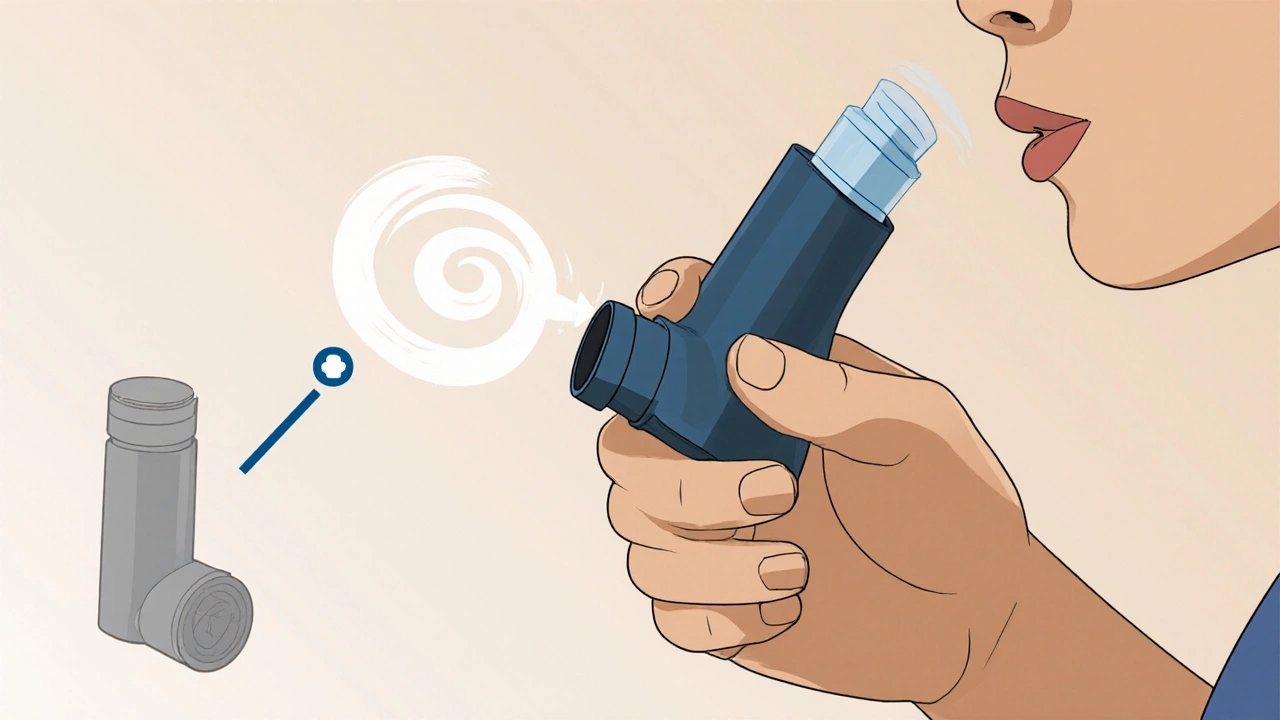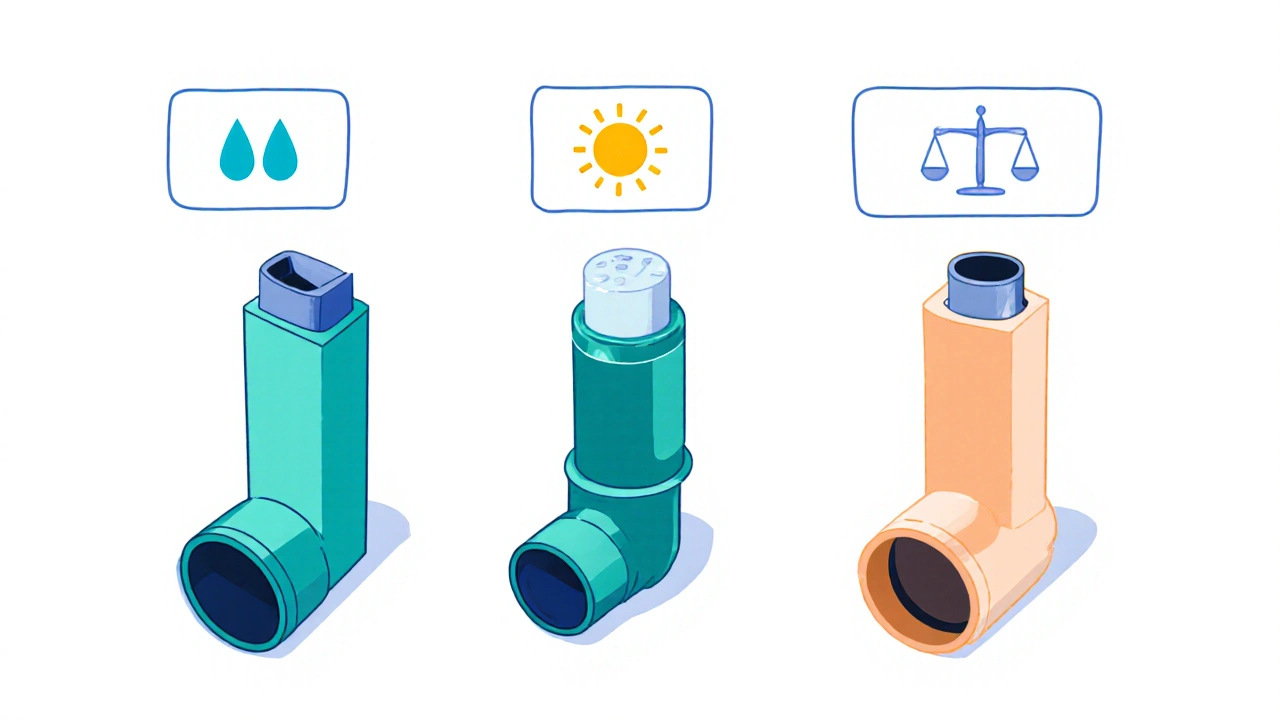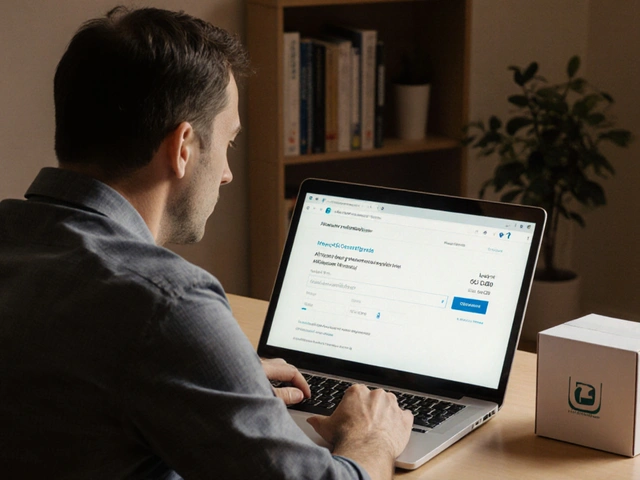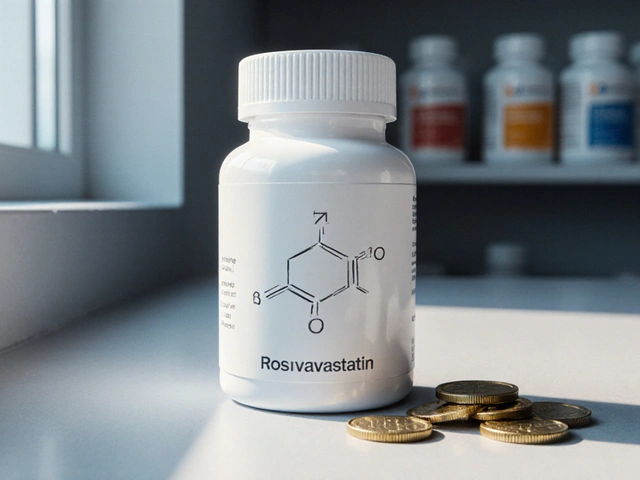Asthma/COPD Inhaler Comparison Tool
Find Your Best Inhaler Match
Answer a few questions about your needs and preferences to get a tailored comparison of popular inhalers for asthma and COPD.
Recommended Inhalers
Important: This tool provides general guidance based on article information. Always consult your healthcare provider for personalized recommendations.
Quick Takeaways
• Symbicort Turbuhaler combines a long‑acting β₂‑agonist with an inhaled corticosteroid in a breath‑actuated device.
• It delivers 60 µg of formoterol and budesonide per puff, suitable for moderate‑to‑severe asthma and COPD.
• Alternatives differ in device type (diskus, DPI, pMDI), dose flexibility, and side‑effect profiles.
• Cost and insurance coverage often tip the decision more than pharmacology alone.
• Matching the inhaler to a patient’s inhalation technique and lifestyle is the biggest predictor of success.
What Is Symbicort Turbuhaler 60MD?
Symbicort Turbuhaler 60MD is a combination inhaler delivering 60 µg of formoterol (a long‑acting β₂‑agonist) and budesonide (an inhaled corticosteroid) per actuation, used for asthma and COPD management. The Turbuhaler is breath‑activated, so you don’t need to coordinate a puff with a click. Formoterol relaxes airway muscles for up to 12 hours, while budesonide reduces inflammation over the long term. This dual action lets many patients stay controlled with a single device instead of juggling separate rescue and maintenance inhalers.
How the Combination Works
- Formoterol - a LABA (long‑acting β₂‑agonist) that binds to β₂ receptors on smooth muscle, causing bronchodilation that lasts around 12 hours.
- Budesonide - an inhaled corticosteroid (ICS) that dampens the immune response, decreasing mucus production and airway swelling.
Together they address both the reversible constriction and the chronic inflammation that drive asthma attacks and COPD flare‑ups. Studies from 2023‑2024 show that patients on the 60 µg formulation achieve a mean improvement of 0.22 L in FEV₁ compared with separate LABA/ICS inhalers, while reporting fewer daily inhalations.
Key Attributes to Compare
When you line up Symbicort against other options, focus on these attributes:
- Device type - DPI (dry‑powder inhaler), pMDI (pressurised metered‑dose inhaler), or nebuliser.
- Fixed vs. flexible dosing - some inhalers let you adjust the steroid dose.
- Frequency - twice daily vs. once daily.
- Cost and insurance coverage - generic equivalents can be dramatically cheaper.
- Side‑effect profile - especially oral thrush, hoarseness, or tachycardia.

Popular Alternatives
Below are the most frequently mentioned alternatives in clinical practice and patient forums.
- Advair Diskus (fluticasone/salmeterol) - DPI, twice‑daily, widely covered by US Medicare.
- Breo Ellipta (fluticasone/vilanterol) - once‑daily DPI, higher total steroid dose per inhalation.
- Pulmicort Respules (budesonide) - nebulised solution, used for children or severe COPD.
- Relvar Ellipta (fluticasone/vilanterol) - similar to Breo but marketed for COPD primary indication.
- Ventolin HFA (albuterol) - pMDI rescue inhaler; often paired with a separate maintenance inhaler.
- Mometasone/Formoterol (e.g., Dymista Nasal) - nasal spray, not an inhaler, but occasionally mentioned for allergic rhinitis as a complementary therapy.
Side‑Effect Snapshot
All inhaled LABA/ICS combos share a core set of potential adverse events. The table below highlights where each product differs.
| Inhaler | Device | Daily Dose (µg) | Frequency | Typical Cost (US$) | Common Side Effects |
|---|---|---|---|---|---|
| Symbicort Turbuhaler 60MD | Dry‑powder (breath‑actuated) | Formoterol 120 µg + budesonide 480 µg | 2×/day | ≈$250 for 60 doses | Oral thrush, hoarseness, mild tremor |
| Advair Diskus (500/50) | Dry‑powder (diskus) | Formoterol 100 µg + fluticasone 500 µg | 2×/day | ≈$200 for 60 doses | Thrush, cough, palpitations |
| Breo Ellipta (100/200) | Dry‑powder (once‑daily) | Formoterol 100 µg + fluticasone 200 µg | 1×/day | ≈$300 for 30 doses | Thrush, headache, tachycardia |
| Pulmicort Respules (0.5 mg) | Nebuliser solution | Budesonide 500 µg (per nebulisation) | 2-4×/day | ≈$40 per 5 ml vial | Hoarseness, oral candidiasis |
| Relvar Ellipta (100/250) | Dry‑powder (once‑daily) | Formoterol 100 µg + fluticasone 250 µg | 1×/day | ≈$280 for 30 doses | Thrush, sore throat, arrhythmia (rare) |
Choosing the Right Inhaler for You
Every patient’s situation is a mix of clinical need, lifestyle, and budget. Below is a decision guide that translates the data into practical steps.
- Assess inhalation technique. If you struggle with the force required for a DPI, a pMDI with a spacer or a nebuliser may be safer.
- Consider dosing frequency. Once‑daily devices (Breo, Relvar) improve adherence for busy adults, while twice‑daily options give more flexibility for dose adjustments.
- Check insurance formularies. Many plans list Advair as a preferred brand, dropping the copay by 30‑40 % compared with Symbicort.
- Factor in comorbidities. Patients with frequent oral thrush may benefit from a device that includes a built‑in mouth‑piece guard (e.g., Turbuhaler’s foil cover).
- Review cost per therapeutic gram. Divide the total price by the total µg of steroid delivered to see the true economic impact.
In practice, clinicians often start with the inhaler the patient can use correctly, then tweak the regimen if control remains suboptimal.
Potential Pitfalls and How to Avoid Them
- Improper storage. Keep DPIs away from humidity; a damp device can clump the powder and reduce dose.
- Skipping the rinse. Rinsing the mouth after each dose cuts oral thrush risk by up to 70 %.
- Mixing rescue and maintenance. Using a rescue inhaler more than twice a week signals that the maintenance dose may be too low.
- Assuming “once‑daily = better”. Some patients need the more even plasma levels from twice‑daily dosing.
Frequently Asked Questions
Can I switch from Symbicort to Advair without a doctor’s order?
No. Both drugs contain a LABA/ICS combo, but the steroid type and dose differ. Switching without medical oversight can lead to under‑ or over‑treatment and may affect insurance coverage.
Is the Turbuhaler easier to use than a Diskus?
Many patients find the breath‑actuated Turbuhaler simpler because there’s no need to slide a lever. However, it requires a strong, steady inhalation; people with weak inspiratory flow may prefer the Diskus’s sliding mechanism.
What’s the biggest cost driver for these inhalers?
Brand‑name pricing dominates. A generic budesonide inhaler can be under $50 for a month’s supply, while branded combos like Symbicort or Breo often exceed $250. Checking pharmacy discount cards or patient assistance programs can shrink the gap.
Do I need a spacer with Symbicort Turbuhaler?
No spacer is needed because the Turbuhaler is a dry‑powder device, not a pressurised metered‑dose inhaler.
Can children use Symbicort Turbuhaler?
It’s approved for children 12 years and older. Younger kids usually need a nebulised budesonide solution or a child‑friendly pMDI with a spacer.
Bottom Line
Symbicort Turbuhaler 60MD offers a reliable twice‑daily LABA/ICS combo in a breath‑actuated DPI, making it a solid choice for many adults with asthma or COPD. Alternatives like Advair Diskus and Breo Ellipta bring different dosing schedules and device mechanics that may better fit certain patients’ preferences or insurance plans. Use the comparison criteria-device type, dosing frequency, cost, side‑effects-to match the inhaler to the individual’s needs, and always confirm the switch with a healthcare professional.







Alisha Cervone
October 26, 2025 AT 17:32The Turbuhaler seems fine but the price is steep.
laura balfour
November 1, 2025 AT 15:12Wow, the sheer breadth of options can feel like staring into a never‑ending hallway of choices – it’s almost dramatic, like a theatre of inhalers! I reckon the breath‑actuated Turbuhaler is a hero for those who love simplicity, but don't forget it demands a solid inhale flow, otherwise you might as well be chewing gum. Advair Diskus, on the other hand, offers a sliding lever that some folks find intuitively easier, especially if they’ve been using inhalers for years. The cost factor? Oh dear, that can turn a dream into a nightmare – a brand‑name combo easily outscores a generic budesonide by a hundred bucks. If you’re juggling insurance forms, check the formularies, because a slight tweak can save you a ton of cash. And don’t overlook humidity; a damp DPI can clump the powder and turn your daily dose into a gamble. Anyway, pick what matches your breathing rhythm and wallet, and maybe the battle will feel a bit less epic. (Sorry about the typo – definatly )
Hope this helps!
Ramesh Kumar
November 7, 2025 AT 12:52When you compare the Symbicort Turbuhaler 60MD to its peers, the first thing to notice is the dual‑action formulation of formoterol and budesonide, which provides both bronchodilation and anti‑inflammatory effects in a single breath‑actuated device. The 60 µg dose delivers 120 µg of formoterol and 480 µg of budesonide daily, which aligns with guideline‑recommended dosing for moderate‑to‑severe asthma and COPD.
Clinically, studies from 2023‑24 have shown an average FEV₁ improvement of about 0.22 L compared with taking separate LABA and ICS inhalers, indicating better airway stability.
From a pharmacokinetic standpoint, the breath‑actuated mechanism reduces coordination errors that are common with pMDIs, especially in older adults or those with limited dexterity.
However, the Turbuhaler requires a relatively high inspiratory flow; patients with severe airflow limitation may not achieve optimal drug deposition, making a nebulised budesonide option like Pulmicort Respules more suitable.
Cost is another pivotal factor – the branded Turbuhaler typically runs around $250 for a 60‑dose pack, whereas generic budesonide inhalers can be found for under $50, representing a substantial savings for long‑term therapy.
Insurance formularies often favor Advair Diskus or Breo Ellipta, so checking your plan’s preferred brand before prescribing can prevent unexpected copays.
Device handling also matters: the Turbuhaler’s foil cover protects the powder from moisture, but any exposure to humidity can cause clumping and dose variability, so store it in a dry place.
Patients should be reminded to rinse their mouth after each dose to mitigate oral thrush risk, which is reported in up to 7 % of users on LABA/ICS combos.
Adherence tends to be higher with once‑daily devices like Breo Ellipta, yet many find the twice‑daily schedule of Symbicort easier to integrate into a morning and evening routine, leading to more consistent dosing.
Switching between inhalers without medical guidance can result in under‑ or over‑dosing, especially since steroid potency varies between budesonide and fluticasone.
In pediatric populations, the Turbuhaler is approved for ages 12 and up; younger children usually need a nebuliser or a pMDI with a spacer.
Overall, the choice should balance inhalation technique capability, dosing frequency preference, side‑effect profile, and financial considerations.
For patients who can generate adequate inspiratory flow and have insurance coverage, Symbicort offers a reliable twice‑daily regimen with proven efficacy.
Conversely, if cost is prohibitive or inspiratory force is limited, alternatives like Advair or a generic budesonide inhaler might be more appropriate.
Always involve the patient in the decision‑making process to ensure the selected device aligns with their lifestyle and health goals.
Barna Buxbaum
November 13, 2025 AT 10:32Great overview! If you’re unsure about inhalation strength, try a quick test with a peak‑flow meter – it’ll tell you whether a DPI like the Turbuhaler is feasible. For those who struggle, a pMDI with a spacer can be a lifesaver and still deliver the same medication. Keep an eye on your insurance formulary; sometimes a seemingly pricier brand will be covered at a lower copay than a cheaper generic. And remember, rinsing your mouth after each dose cuts thrush risk dramatically. Stitching all these pieces together usually lands you on the right inhaler for your daily routine.
asha aurell
November 19, 2025 AT 08:12If cost dominates your decision, generic budesonide inhalers are markedly cheaper than branded LABA/ICS combos. Also, consider inhaler technique – a weak inspiratory flow makes a DPI less effective.
Miracle Zona Ikhlas
November 25, 2025 AT 05:52Choosing an inhaler should feel empowering, not stressful – focus on what fits your daily rhythm. A quick demo with your pharmacist can clear up most doubts.
naoki doe
December 1, 2025 AT 03:32While a quick demo is helpful, don’t forget that many patients overlook the importance of regular maintenance checks; a device that seemed perfect last month might be compromised by humidity today.
sarah basarya
December 7, 2025 AT 01:12Honestly, the drama around “once‑daily is better” is overblown – some folks genuinely need the steadier plasma levels from twice‑daily dosing, and that’s a fact, not a myth.